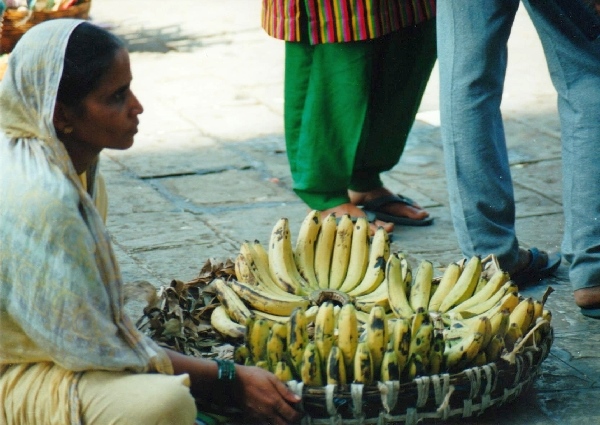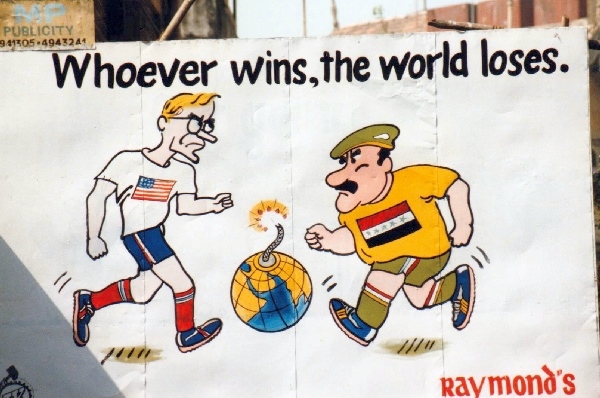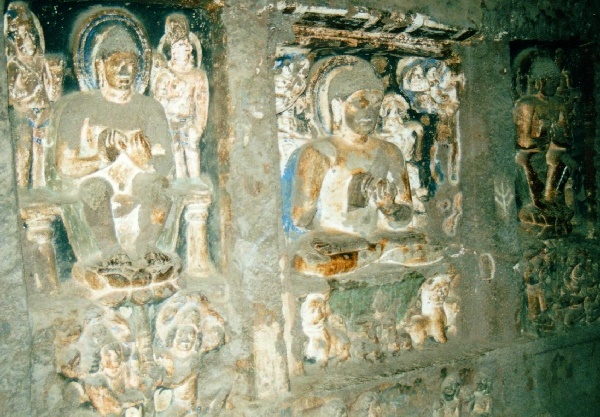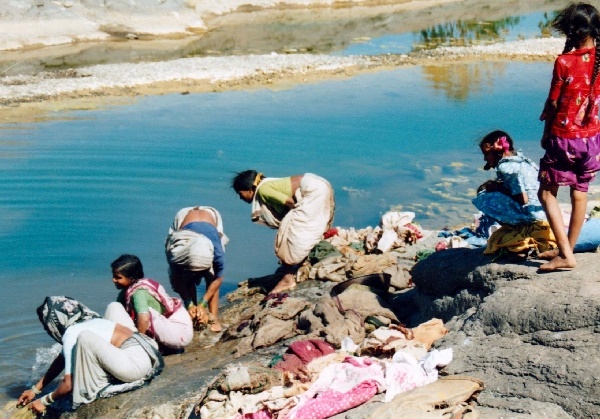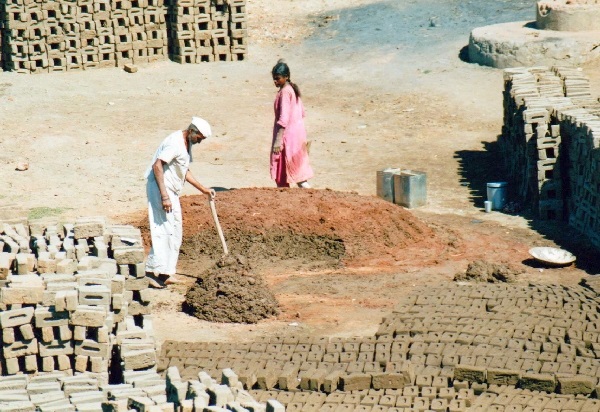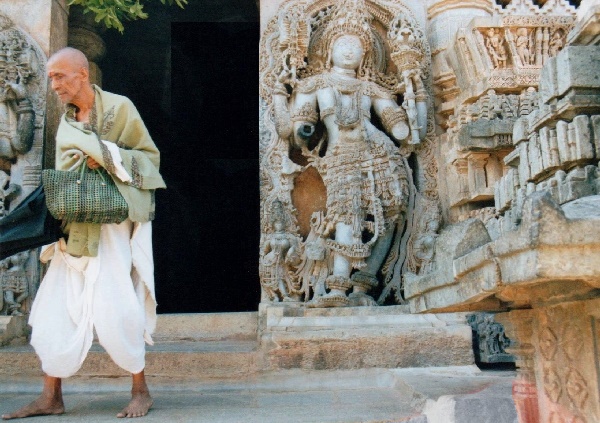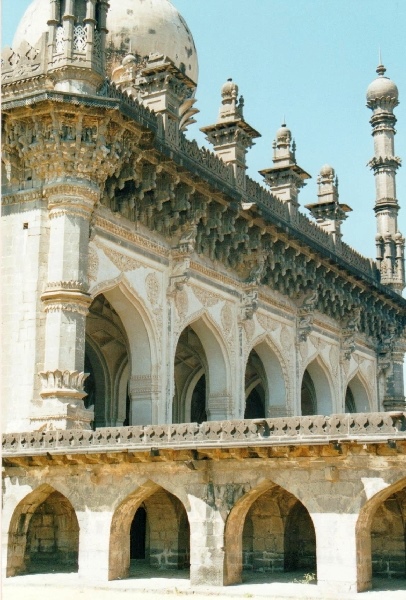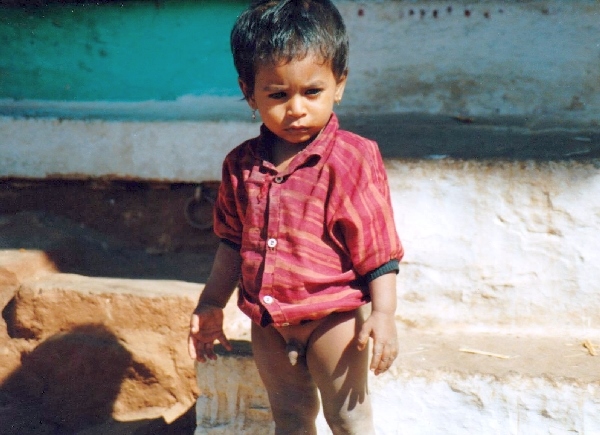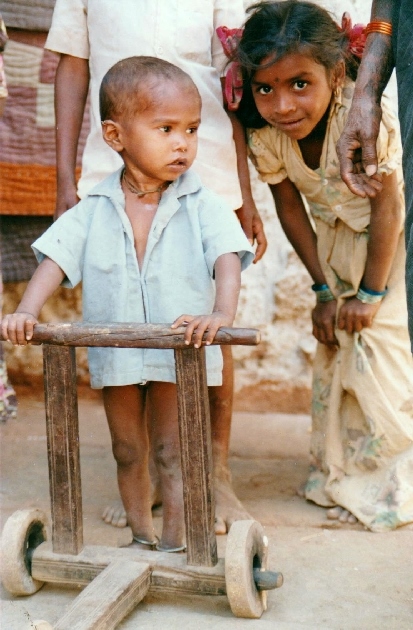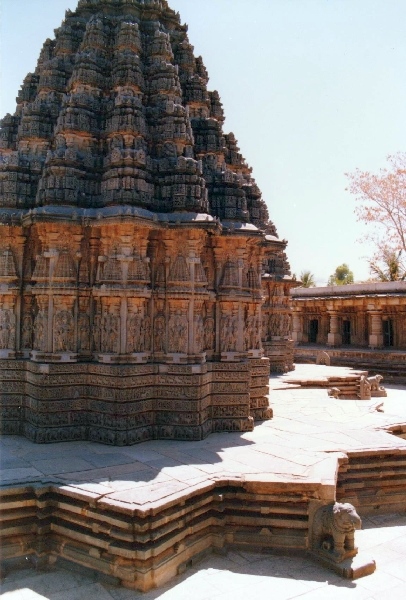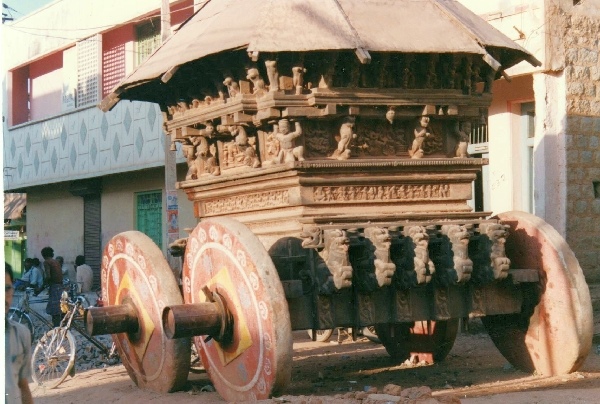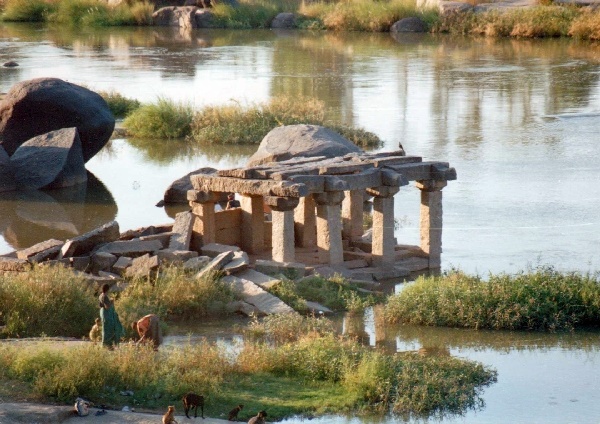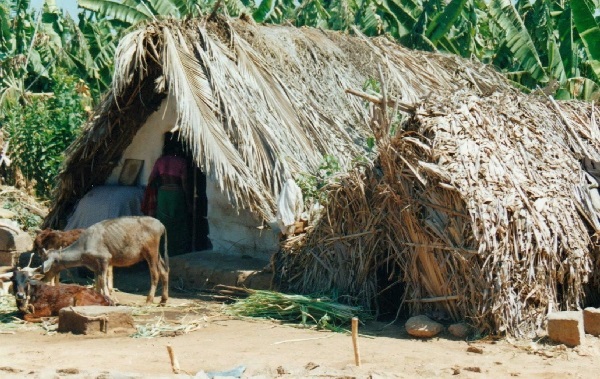World traveler Clown Tom Bolton
Adventure stories & photos

Tom’s travels to Southern India
Mumbai – Bombay, India
I had made my first trip to northern Indian in 1990. My second one was a 2 month journey to southern India one year later. I arrived in the third week of Jan. in Bombay or Mumbai as it has in the meantime been renamed. It is the capital city of the Indian state of Maharashtra and is the most populous city of India.
Bombay Landmark – Gateway of India
This monument to commemorate the visit of the King and Queen of England in the harbor is known as “The Gateway of India” as it would be the most prominent thing one would see upon arriving there by sea.It is one of the most known landmarks in Mumbai if not all of India, aside from the Taj Mahal. It was a lively place to hang out, always full of Indian tourists, street sellers, shoe shiners etc. Most of the vendors had their wares in a suitcase or on a cloth, which they could close quickly or grab together and run when the police made their periodic sweeps.
Rather than the mounted telescopes one sees at points of interest in much of the world, here the telescopes were carried around by the Bombay locals who would swarm around you pestering you to use THEIR device. I doubted their scopes were any good but at least they had something to put it on. My good camera tripod had gotten damaged during my flight.
The airlines said it was no problem to get compensation, I just needed to drag it around with me the whole time and take it back to Europe and present the receipt. Likely they would have then claimed that I should have settled the matter in India instead of months later – so I never bothered to file a claim. I considered to just throw it away but kept it in the end yet hardly used it.
Harbor view of the Gateway of India from boats
The harbor there is a major Bombay transit point to many water reached destinations but also popular for sight-seeing boats. It was a lot less hectic to see the harbor area from the boat. Seems there were a lot of big fancy hotels in that neighborhood. I believe the one to the left of the picture is the Taj Hotel, one of the main targets of the big 2009 Mumbai terrorist attack. Strange to see that the attack started at the Leopold Cafe. This was a popular hangout for many westerners including myself in 1991, as it was 2 doors down from the hotel where I first stayed! I changed after a couple of days as there were renovations going on creating not just noise but the occasional show of plaster falling from my room ceiling.
Gharapuri – Elephanta Island
I also caught a boat from near the Gateway over to Gharapuri better known as Elephanta Island. This is a popular Bombay excursion. The attraction there is the intricate cave temple, which took an hour each way and 2 hours at the site. It was a climb of many steps up to the cave and I had been scornful this western woman who had hired porters to carry her. But by the time I descended, my own legs were shaking from exhaustion. There was another small island we passed on the way back to Bombay that is said to have a nuclear research and production facility. One wonders what would have happened if the terrorists had attacked it with the same level of success as their other targets.
Chowpatty Beach, Bombay
Another place where the Bombay locals loved to hang out was at Chowpatty Beach. One wonders about the name of course, that it is so close to cow patty makes you wonder. But then I had seen a lot of cows running around Delhi but virtually none in central Bombay. People didn’t much sunbath or even swim at the beach in Mumbai but relaxed and made picnics. But when you consider the size of the mega-city surrounding this small beach and how much garbage and pollution there is, who would be crazy enough to go in the water.
There was a human-powered Ferris wheel and other rides for the kids. Lot of guys had horses, which they spent as much time thundering down the beach trying to look macho as they did offering people rides. Seemed that everyone had some kind of business going. Quite a few young guys would try to have you pose for a picture with their monkey. Drinks, cotton candy, ice cream and other snacks were hawked from small carts.
I stuck to eating in restaurants to be on the safe side. I also took the opportunity in Bombay to eat something other than Indian food. I went to the place touted by Lonely Planet as having the best Chinese food in India. It was pricey and nothing spectacular, which said a lot more about the low level of foreign food in India than anything about this specific eatery.
Prince of Wales Museum
Prince of Wales Museum has since then renamed Chhatrapati Shivaji Maharaj Vastu Sangrahalaya. It was one of the other highlights to see in Bombay. This was probably the best museum I saw in the country. It is enclosed in the Victoria Garden in Central Mumbai. Things were well displayed with good English explanations provided. The displays include art, archaeology and natural history. I especially liked the overview of Indian animal wildlife.
Bombay Zoo
I took these photos in the Bombay Zoo, which is also situated in the Victoria Gardens. Respect for animals’ lives is instituted in Hindu culture. Even snakes and rats are somehow holy. But as the population increases, the wildness that shelters many of Indians amazing animals is disappearing. The zoo seemed a rather sad replacement and for me was a more interesting place to observe people than the animals. So many people living in a concrete jungle like Bombay that the zoo was a place of freedom where one could sit under shady trees and relax a bit from the chaos outside. The bus to the zoo went through a predominately Muslim neighborhood. Was a beautiful blue mosque there, situated across from what appeared to be a Jewish cemetery.
Poverty not due to laziness
These were scenes from the streets of Mumbai. There were many women working at this Bombay construction site; carrying loads of dirt, breaking rocks with sledgehammers. Some even had a baby and/or a small child at their side. Anyone who claims Indians are simply lazy is full of it. Such poor people don’t have the luxury to do anything but work hard to survive. And the people so down and out that they have to beg are usually handicapped like this crippled guy. Rock bottom is just lying in the middle of the sidewalk in the direct sunlight at 38 degrees Celsius. Not sure how one even survives this.
Gulf crisis; anti-war sentiments
The big event on the world stage during my trip was the first Gulf War, which had stared a week before I arrived. There were many demonstrations and protests in bombay. Many were against war in general rather than just anti-American like most of the ones I had recently witnessed in Germany. Not that I was for war but I thought it strange for Germans to yell about the US after having said little to nothing about Sadhus provocations which lead up to the conflict.
As Saddam heated up the conflict by hitting Israel with scud missiles, a German politician had the courage to openly state his shame that Jews were facing the threat of gas attacks with chemicals made in Germany. This strongly made the point that German industries had supplied much of Iraq’s military hardware. The slogan “no blood for oil” was pretty much on the mark but the continuation should have been “but we want the oil anyway”. I believe the following 3 photos are actually from Hyderabad rather than Bombay but they are very representative of images I saw in Bombay and throughout this trip.
Anti-Americanism
There were plenty of anti-American sentiments as well. India has tens of millions of Muslims who were pretty riled up about the situation. But even many Hindus, who had recently had their own violent conflicts with Muslims, were against the US. Seems they saw it as a case of the big bully Bush ganging up on a small country like Iraq and America’s support of their enemy Pakistan is never overlooked.
Obviously, I didn’t advertise that I was American especially when approached a couple of times by guys who said, “Hi, if you’re American, I will kill you!” I even had my hair cut at a barbershop for 10 rupees but started to reconsider my decision when the barber insisted on shaving the back of my neck with a straight razor. Turned out that a few westerners did get murdered in India during the war by people who assumed they were Americans but none of them actually were. Not all of these images were taken in Mumbai but I chose relevance over location to include them all here.
Glorification of Saddam Hussein
No idea what this street vendor’s political leanings were since they sell whatever people are willing to buy but I don’t remember seeing any pro-Bush or anti-Saddam shirts on offer. I think I actually took this photo later in Mysore rather than in Bombay but the sentiments were similar all over.
Conspiracy theories popular in India
I actually saw a number of churches in Bombay, legacy of the colonial period and it caught my eye when I saw another street seller offering a book that claimed that Jesus had traveled for some years in India, after having actually survived the crucifixion. It mentioned that when the Portuguese arrived in India, they found that there had already been Christians there for 500 years but none had ever even heard of the pope. Supposedly Saint Paul had been in a shipwreck and evangelized his way through India. Not sure if anyone had spotted Elvis eating a curry somewhere recently or not.
Searching for Parsi temple
A popular sight in Bombay is the hanging gardens and something unusual – the nearby Parsi temple that I looked for in vain and gave up after getting blisters. The Parsis leave their dead on the roof tower of the temple for the birds to eat and I kept looking without luck for circling vultures and buzzards. From a wester perspective tis seemed pretty outrageous but from an ecological stand point maybe it is even better than cremation. From Bombay I had to decide where to go next and opted for a night train to Jalagon to visit the Ajanta caves.
Ajanta caves
There are caves in the cliff of Ajanta that were extended and intricately carved as temples over many hundreds of years. The reliefs were much more amazing than what I had seen at Elephanta Island. Both the caves of Ajanta and Ellora were full of carvings, which concentrated on showing Hindu figures but also many of the Buddha, which the Hindus regard as an incarnation of one their gods.
Curious local kids by Ajanta
These kids came from a village near Ajanta caves to see the tourists. I amused them by juggling with stones, and then one of them noticed metal in my mouth. I have a few missing teeth and used to wear partial dentures. As I pulled the “teeth” out of my mouth they were even more amazed, as if I were a cyborg removing my own head or something equally bizarre from a science fiction film.
Ajanta, river for laundry & brick making
There was a river running along below the cliffs where the Ajanta Caves were located. The villagers there were washing laundry. There was also a brick making facility. No building, just doing it all outside and putting them into a kiln. The oxcart seemed to be used for transporting bricks.
Aurangabad – “fake Taj Mahal” Bibi Ka Maqbara Mausoleum
From the Ajanta Caves I returned to Jalagon and caught a bus to Aurangabad. One thing of note I wrote down about this trip was seeing a Pepsi for the first time. Since the previous year, India had finally decided to open up its markets to international firms again. Pepsi and 7 Up were at the forefront of this invasion and I would soon see them even being sold out of bicycle carts in remote places. So despite what I assumed, some things could change there very rapidly indeed.
One of the big attractions in Aurangabad, in addition to their own temple cave, was the Bibi Ka Maqbara Mausoleum known as the “fake Taj Mahal” The architectural style was similar and the grounds were nice but it was run down and seemed to be painted cement with an occasional slab of marble thrown in for looks. Quite a difference to the luminous stone inlayed with intricate gems of the original in Agra. The visitors to the mausoleum and Mosque were more interesting than the building itself. Aurangabad was a village and the people there more on the rural side of life if one judges from some typical scenes there.
Ellora Caves
Day tripping from Aurangabad. I rented a bicycle the next day to look around the town after first going to train station to get ticket for the following day to Secundebad after a planned day trip to the Ellora caves and the fort at Daulatabad. The Ellora caves actually had many free standing temples which seemed to be carved right out of the hillsides in one piece and were more prominent than the caves themselves. Both inside and especially out, there was more intricacy in the elaborate carvings. Done over many years there were both monasteries and temples – and both Hindu and Buddhist. I think there were around 29 cave/temple complexes and by the time I got through I was pretty much templed out!
Daulatabad Fort
The fort at Daulatabad was not so impressive on its own but the surrounding was spectacular with massive walls and moats for fortification and secret passages to waylay invaders.
Hyderabad – Charminar Mosque & Monument
I got the train to Secundebad and 3-wheeled motorcycle rickshaw taxi to nearby Hyderabad. Paid more than I expected for the taxi even after bargaining but then they were all claiming that fuel prices were skyrocketing as Saddam had released oil into the sea and would soon be setting fire to the oil wells in Kuwait. One of the city landmarks is the centrally located Charminar Mosque. It’s large archways give the appearance that one could drive through it on the surrounding busy street. Vehicles had to drive around but their noise and exhaust drove straight through. One heck of a traffic circle monument anyway.
Hyderabad – Mecca Masjid Mosque
The Mecca Masjid Mosque was also an impressive and extensive site located near the Charminar Monument.
Hyderabad – Osmania hospital
From a distance one would assume this was a palace or temple but it is actually the Osmania hospital. I didn’t go inside but have read that it is one of the biggest hospitals in India. The conditions are said to be rather shocking although they have extensive technology and services. But it is set up to provide care for the destitute, which is commendable but results in pervasive over-crowding.
Hyderabad slums, laundry on the river
There was also a slum on the riverbank near the hospital so it looks like they have plenty of potential clients for the hospital. The people washed cloths in the river. There were so many hanging up that I assume they were doing a laundry service rather than just their own stuff. In the same area where they did laundry people bathed and swam along with a bunch of oxen cooling off.

Hyderabad Golconda Fort, Qutb Shahi Tombs
The main attraction in town is the Golconda Fort. I had taken my tripod along although it was damaged and as I tried to use it to take a picture, a guard came and aggressively said tripods were not allowed. He made me go to the office and gave me a lot of shit. I apologized profusely although I still don’t know what damage a tripod should cause. He continued on as if I were a criminal and should be fined and taken to the police. I finally just said “bullshit” and left but unfortunately without having seen much of the site. Thus I have just one shot of the exterior and one lousy one of the interior archways. About a kilometer from the fort was another spread out site known as the Qutb Shahi Tombs. I have just a panorama view of the site (below left) that includes 23 mosques, 40 mausoleums, a haman and some pavilions. This was built by and contains the remains of various local sultans.
Hyderabad scenes by temple
Walking around town I passed this temple but didn’t go in. Just liked the scenes of the priest coming out and the old guy eating watermelon.
I changed a traveler’s check in a bank in Hyderabad. Ahead of me, an Indian couple presented a suitcase full of rupees, then left and returned 15 minutes later with another suitcase full of cash. No idea what that was about. After I had my experience at the fort I tried to just relax in some gardens but people were constantly pestering me so I felt I was ready to move on.
Foreigners are constantly approached in India, not so much by beggars as one would expect but out of sheer curiosity. And the most popular subject is sex. If you are a western female, if you wouldn’t like to “have some”, if you are a western male, have you “had some already”. It’s all rather naive and annoying but the Indian society is curious and very sexually repressed.
I had wanted to take a night train from Hyderabad to Hospet but one had to make reservations days in advance so I got an evening bus to Bijapur, which was a nightmare. There was a lot of aggression at the chaotic station, seemed some buses were cancelled because of fuel shortages and I even saw people surrounding a prostate body but I thought it wise not to get involved.
Bijapur – Ibrahim Rauza Mausoleum
Bijapur in the mean time also known as Vijayapurahas has an old fort complex, old city and the following images of the Ibrahim Rauza Mausoleum. It is an extensive complex surrounded by gardens. There was a museum but it was closed. The city seemed very relaxed compared to Hyderabad, more people riding around in oxen drawn carts than cars. I rented a bike for the day to get around and felt relieved not to have to hassle with buses or rickshaw drivers. Did have one guy walk by and shout “Saddam Hussein” – guess he must have mistaken me for some guy named Hussein just like everyone in the Philippines mistook me for their friend Joe and the Indonesians for that “hey mister” character.
Bijapur – Gol Gombaz Mausoleum
One of the other main sites in Bijapur is Gol Gumbaz aka Gol Gumbadh. It is the mausoleum of Mohamed Adil Shah the former Sultan of Bijapur. The outstanding feature was the size of the main domed roof. It is the largest of its kind in India and one of the biggest in the world.
Bijapur – Jama Masjid Mosque
There was also a huge mosque in Bijapur built by Mohamed Adil Shah. I’ve seen it written Jami or Jama or Jamiya Masjid. It is supposed to be the biggest Mosque in the region so I guess it needs more than one variation on a name. Built to commemorate his victory over the Vijayanagara Kings, it was never totally completed. It still looked elegant in its simplicity but offers size over intricate details.
Bijapur residents friendly
People in Bijapur seemed friendly and this grandmother was proud to show off her grandchild. Some of my favorite portraits are from this area as people wore such colorful costumes.
Betel nut stains teeth
Thought this guy in Bijapur looked picturesque – like a dentist’s nightmare. But such stained teeth are a common effect of chewing betel nut. Both men and women throughout India chewed betel nut, which seemed more popular at the time than smoking. Also saw a number of men in the area wearing such turbans. This was a style I knew from some cities in Rajasthan in northeastern India.
Bijapur train station
As I was leaving Bijapur I got some last good shots by the train station of these women and children headed to a train. I also saw this family traveling and thought “no wonder Indians tend to be short” since I often saw both men and women carrying heavy loads on their heads. Even on construction sites nobody seemed to have thought of using wheel barrels.

Badami, Karnataka
Although I liked Bijapur, I had seen the sites in a day and went south the next day to Badami in the Indian state of Karnataka on a train that seemed to stop in every small town. There were more temple caves in Badami, which looked very basic from the outside, but I found the style of the carvings inside to outshine what I had seen at Ajanta and Ellora. The most spectacular thing was just the setting with huge cliffs all around. But I had already taken so many temple pictures that I could hardly tell them apart and I didn’t have a good flash for interior shots.
Badami architecture
Most of the dwellings in Badami were simple mud-walled constructions very similar to the adobe dwellings of southwestern USA and Mexico. Their dark earth tones fit to the surrounding hills and were much more attractive than the cinder block construction common in the bigger cities.
Badami friendly residents
The people were also very friendly here, the kids often jumping in front of my camera to have their picture taken, which is such a contrast to the “Indians” of Central and South America who are very camera shy. In India, you take out your camera to make a photo of one person and suddenly you have a couple dozen wanting to be included. I have so many great portraits from Badami that it was hard to decide which to include.
Badami girls
These girls were filling jugs with water. The pride this girl had to present her little sister was touching. Marriages are still arranged in India yet the strong love between family members is often clear to see. This made me reflect a lot on the contrast to our western concept of love including its high incidence of divorce. When I returned to Germany after this trip to India, the woman I had hoped to marry broke up with me. I had suspected this was coming and spent a lot of time in India thinking about relationships.
Rural work in India – sugarcane harvest
Here was a woman working in the sugarcane fields, which were prevalent in this region of India. It looked like hot, backbreaking work, which was done by hand, and not just by men. The harvest sugarcane was piled ridiculously high on carts pulled by tractors or oxen.
Day-trip Aihole Temple Complex
From Badami I made a daytrip by bus (and needed 3 buses to get back!) to see Aihole. It was like an oasis in a rocky dry area with around 100 more temples and monuments spread over 5 square kilometers. The unusual thing was how the architecture varied in style so much. But maybe it shouldn’t be so surprising since it was known for architectural experimentation and built over 800 years. And while it is mostly Hindu, there are also a number of Jain temples and a Buddhist monastery.
Elaborate carvings
Much of the carvings at these temples were very intricate. Popular motifs were animals like elephants and people playing instruments. Clear to see that some forms of fighting skills with grappling and the use of clubs was practiced. Sexual acts were also extensively displayed, which supports the theory that modern prudishness in India was an English influence in contrast to its heritage of such art and books like the Kama Sutra.
Although Badami was great, the mosquitoes at my hotel were driving me crazy. With a couple of other tourists I took a horse-drawn carriage called a “tongo” to the train station to go to Hosapete, which has the nearest stop to Hampi. The horse was in very bad shape and looked like he would die on us. As our time was getting short the driver started to pressure us that we should give him more money – as if the horse’s condition was our fault. I felt sorry for the animal but felt he should give us a discount for the inconvenience if we would miss our train.
Hosapete & Hampi
Upon arrival in Hosapete, I got approached by a guy who asked me where I was from and when I said Puerto Rico he scowled and said he would have killed me if I had said America. Despite that, I stayed in Hosapete while visiting Hampi since there were no hotels there and I didn’t feel like trying to find locals to take me in, which some hippy characters told me is the way it is done there. I notice a lot of drugged out western hippy types who came to Hampi to smoke weed with the many Sadhus.
Hampi UNESCO heritage site
Hampi was the capital of the greatest empire in southern India and is now a UNESCO heritage site. Intricate temples and whole temple complexes still exist but most of it has fallen into ruins, which are scattered throughout the area. Some old temples have been squatted and used for homes, shops and restaurants. There are some great viewpoints looking over the whole Hampi valley. One temple had a “holy” elephant chained up inside. I felt sorry for him and took him bananas but had to be careful of the monkeys who just waited nearby for such an opportunity to snatch a treat. One of the most unique sites is a stone carved chariot depicted being pulled by elephants at the Vittala Temple complex. At another site in the area I saw a chariot made of stone mounted on wheels so it could actually be moved.
Extensive ruins along the river
The modern part of Hampi town is not so interesting but the ruins along the river, which is surrounded by lush vegetation and huge boulders, make for a spectacular setting. Although it looks like such a beautiful, peaceful place, people warned me that many become sick if they dare to go in the water but I don’t know if this is from biological or chemical contamination. This photo is a bit blurry but I love the image of the guy pulling in the boat with his family. There is no bridge there so people cross this wide river in these round boats woven from some kind of reeds. Not the easiest to steer but it works, as the current is rather slow.
Virupaksha Temple
This is the Virupaksha Temple Complex, which has 2 temple buildings designed in a vertical pyramidal style. Many of the walls and ramparts are painted with red and white stripes. I first encountered this architectural style here but it would prove to be popular farther to the south of India.
Hampi Lotus Mahal
The Lotus Mahal monument on the other hand was one of my favorites because it was not large but done in a beautiful style I’ve seen nowhere else. Rather than displaying Hindu deities, it made use of repetitive archways and geometric figures more typical of a Mosque. It is said to have borrowed Islamic designs although built by Hindus. I don’t know the background of this building other than it was built for a queen and designed to maintain a cool atmosphere.

Temples, agriculture
It was very fertile because of the river. Lots of rice paddies, bananas, sugarcane and coconuts growing but also many mosquitoes. Wandering around I came across people drinking water at a well. While many people had moved into the remains of stone temples, others had simple houses like this one with a palm frond roof.
Hanging out in Hampi, beware of dogs
I stayed 5 days in Hampi just wandering around seeing the sites. Were a number of backpackers I hung out with including an American guy who got bitten by one of the many aggressive local dogs and had to go for anti-rabies shots. Most dogs in India lay peacefully in the middle of the dusty roads but some are very aggressive and come in packs. One should ALWAYS carry some good-sized stones in your pocket outside the big cities. An advice valid for many countries is that if threatened by dogs or monkeys, which can also be a danger, and you don’t see any available stones, just fake like you pick up and throw something.
I had intended to leave one day and managed to miss the bus having returned to get the soap I had forgotten. Funny I had seen TV in Hampi and there was a social service announcement promoting not only the washing of hands but to even use SOAP – as if this were a startling new idea… I did get out of Hampi the next day with my soap but also with some unexpected occurrences. All of which is continued on the page: Southern India-2.
So, those were just a few tales from my many travels over the last thirty and something years. I hope you've enjoyed another side of a traveling clown! If you want, write me an email or better yet, book my show or set a link to this website or just state me as the beneficiary of your will!
To book or see more information about Tom's clown show and entertainment, visit one or both of his clown websites:
Clown Stuttgart www.clowntombolton.com
Clown juggler Stuttgart, Gremany www.clown-event.de




